Transport and logistics management
VerifiedAdded on 2023/06/11
|16
|5439
|114
AI Summary
This paper discusses the logistics and supply chain management of Brambles Limited Company, including SWOT analysis, 3PL and 4PL logistics, and issues faced by the company. Suggestions to overcome these issues are also discussed.
Contribute Materials
Your contribution can guide someone’s learning journey. Share your
documents today.
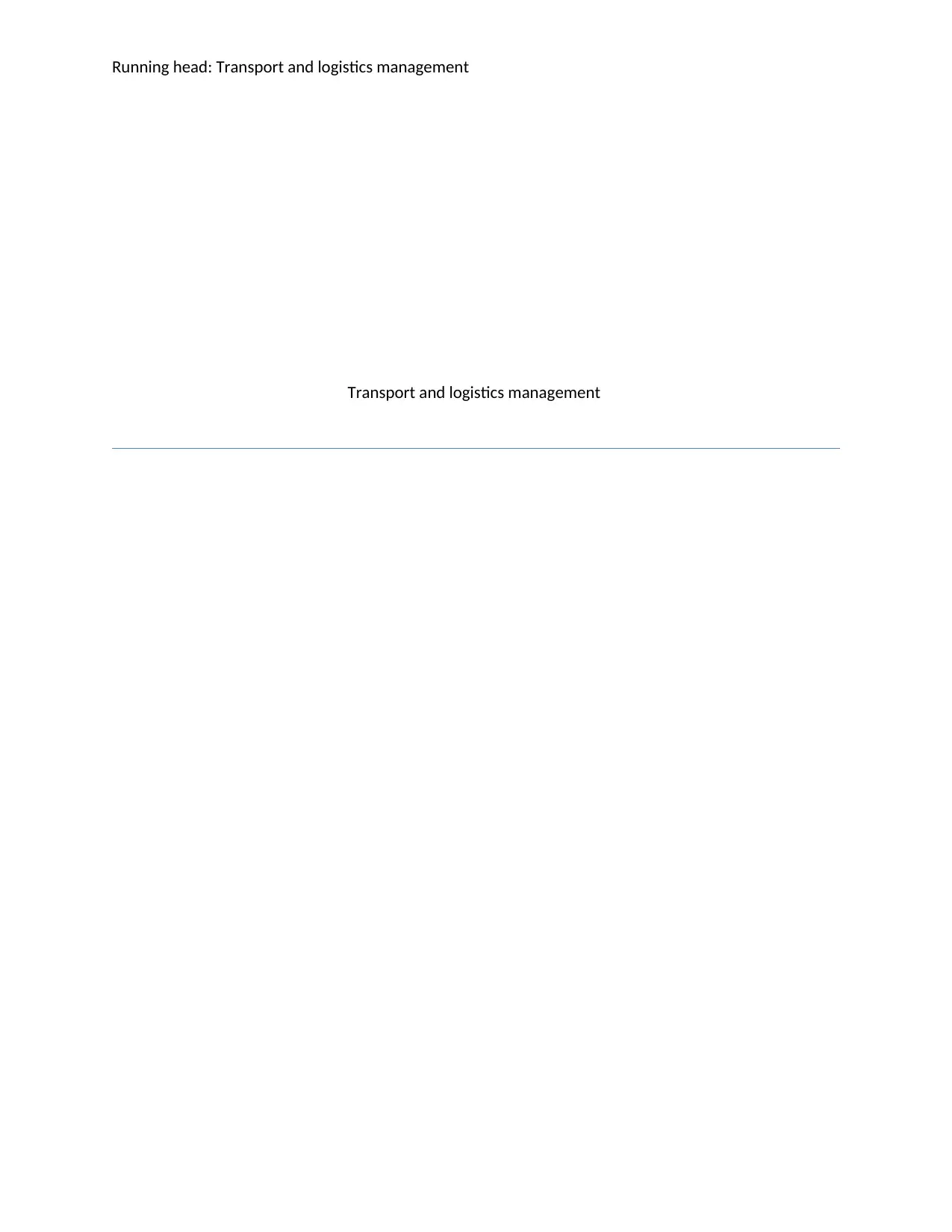
Running head: Transport and logistics management
Transport and logistics management
Transport and logistics management
Secure Best Marks with AI Grader
Need help grading? Try our AI Grader for instant feedback on your assignments.
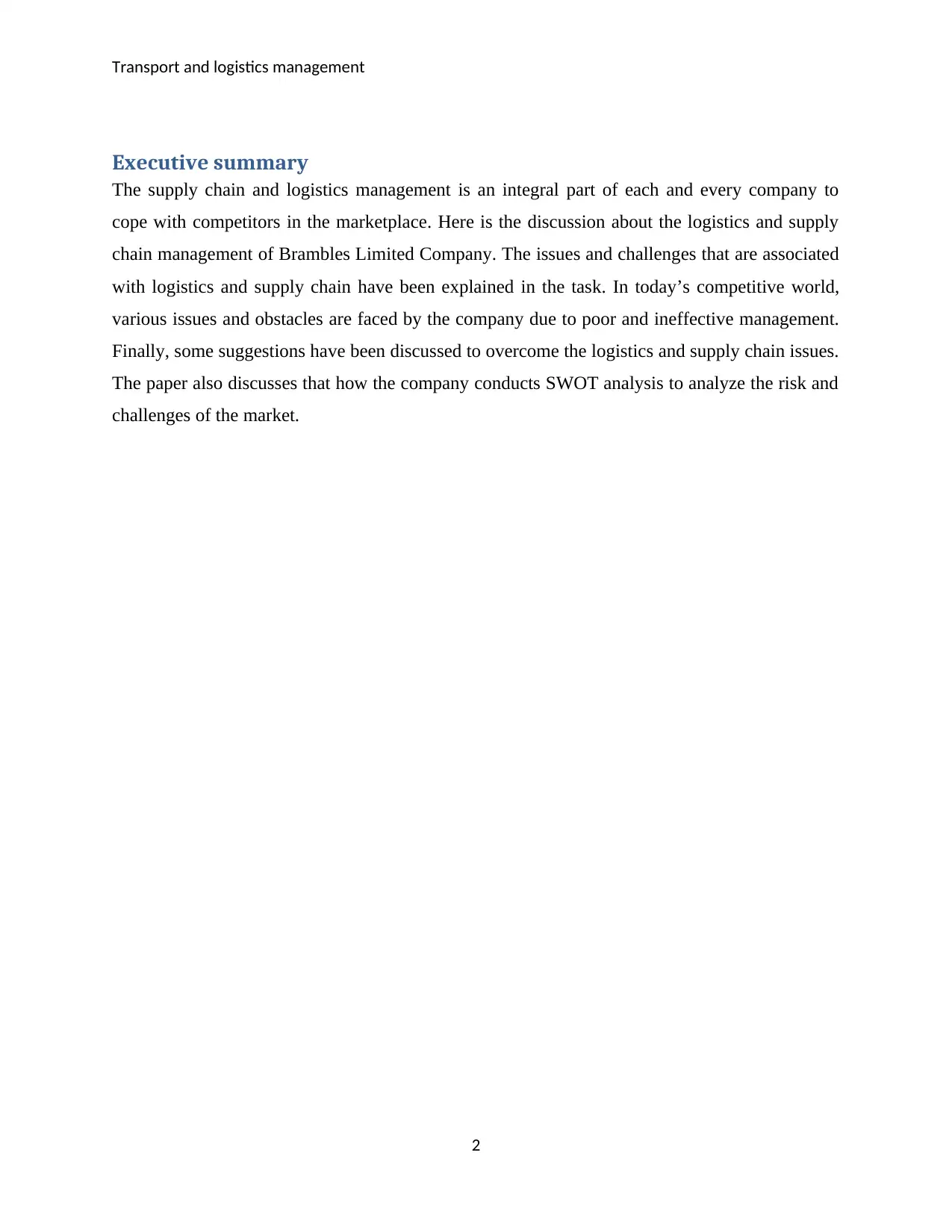
Transport and logistics management
Executive summary
The supply chain and logistics management is an integral part of each and every company to
cope with competitors in the marketplace. Here is the discussion about the logistics and supply
chain management of Brambles Limited Company. The issues and challenges that are associated
with logistics and supply chain have been explained in the task. In today’s competitive world,
various issues and obstacles are faced by the company due to poor and ineffective management.
Finally, some suggestions have been discussed to overcome the logistics and supply chain issues.
The paper also discusses that how the company conducts SWOT analysis to analyze the risk and
challenges of the market.
2
Executive summary
The supply chain and logistics management is an integral part of each and every company to
cope with competitors in the marketplace. Here is the discussion about the logistics and supply
chain management of Brambles Limited Company. The issues and challenges that are associated
with logistics and supply chain have been explained in the task. In today’s competitive world,
various issues and obstacles are faced by the company due to poor and ineffective management.
Finally, some suggestions have been discussed to overcome the logistics and supply chain issues.
The paper also discusses that how the company conducts SWOT analysis to analyze the risk and
challenges of the market.
2
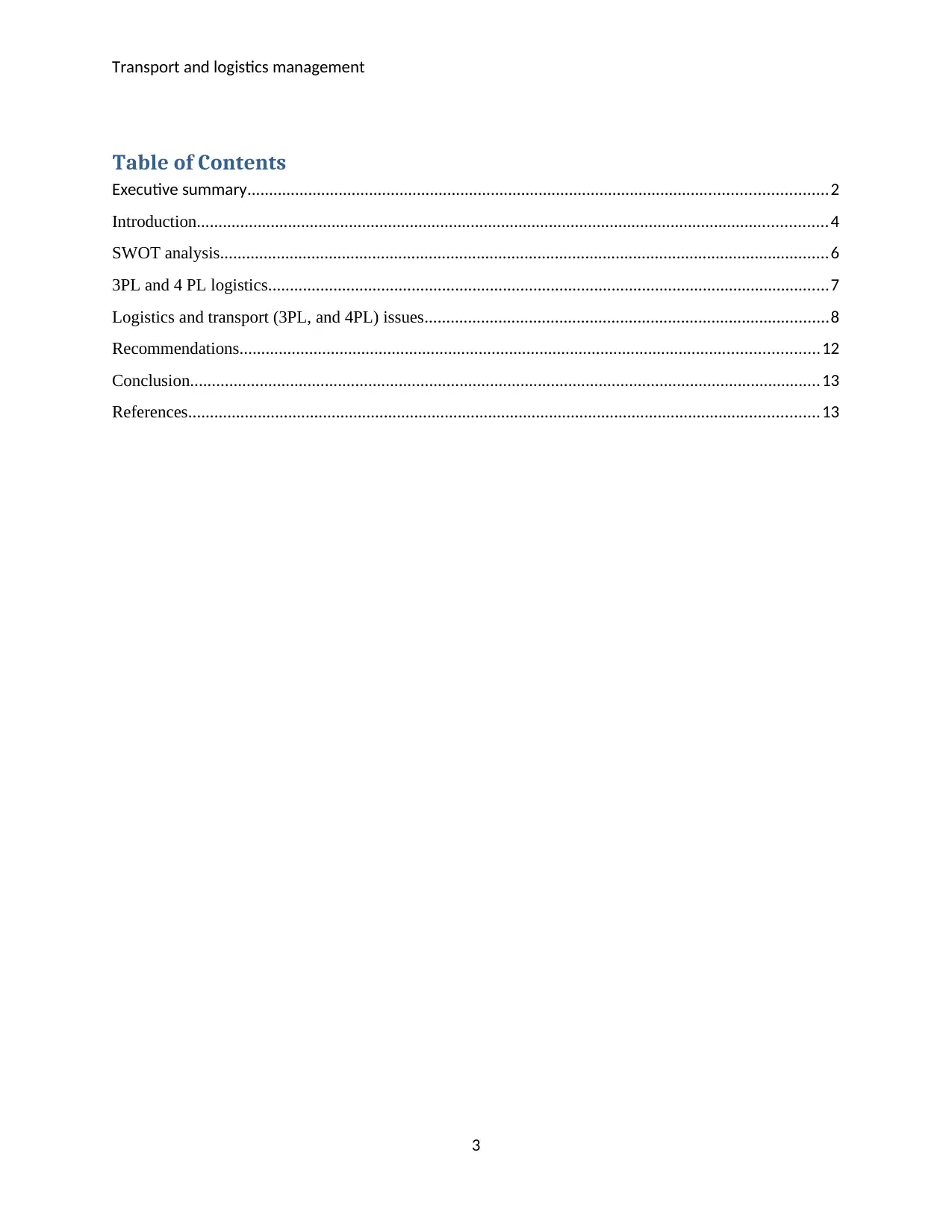
Transport and logistics management
Table of Contents
Executive summary.....................................................................................................................................2
Introduction.................................................................................................................................................4
SWOT analysis............................................................................................................................................6
3PL and 4 PL logistics.................................................................................................................................7
Logistics and transport (3PL, and 4PL) issues.............................................................................................8
Recommendations.....................................................................................................................................12
Conclusion.................................................................................................................................................13
References.................................................................................................................................................13
3
Table of Contents
Executive summary.....................................................................................................................................2
Introduction.................................................................................................................................................4
SWOT analysis............................................................................................................................................6
3PL and 4 PL logistics.................................................................................................................................7
Logistics and transport (3PL, and 4PL) issues.............................................................................................8
Recommendations.....................................................................................................................................12
Conclusion.................................................................................................................................................13
References.................................................................................................................................................13
3

Transport and logistics management
Introduction
The primary objective of the task is to analyze and evaluate the supply chain and logistics
management of Brambles Company that is located in Australia. The firm renders crates, pallets
and containers to the wide range of customers in the international market. The report explains
that how supply chain and logistics management plays significant role in Brambles Company. It
has been noted that the firm cannot satisfy the needs of the customers without using effective and
unique supply chain and logistics management. Along with this, the paper also explains the
issues and challenges related to the supply chain and logistics. The paper outlines that how
logistics and supply issues may influence the productivity and profitability of the firm adversely.
More detail of the task has been discussed below.
Brambles Limited is a holding Corporation of Brambles Group. The company was incorporated
in 1875 having headquartered is located in Sydney Australia. Brambles is a supply chain
logistics group who is dealing with load equipment and associated services. Along with this, the
firm focuses on the outsourced management of pallets, containers and crates. The organization
employs approx 14,000 employees in the organization. It provides pallets, crates and containers
through a network of around 850 service centers. Brambles limited is an ASX listed supply chain
logistics firm with operations in more than 60 countries. The main purpose of the company is to
connect people with life’s essential each and every day. It has been found that the company helps
the customers in transporting the goods more sustainability, effectively, efficiently and safely.
The firm primarily serves the fast moving consumer goods such as grocery, foods, health and
personal care, fresh produce, retail and beverage products. The density and scale of the
company’s network permits a quicker and more response strategy to identify and measure the
trends and changing requirements of the customers in the global market. It is one of the largest
brands across the world (Brambles, 2012).
The mission of the company is to be best leader of innovative business solutions in support
services. Along with this, the organization wants to use outsourcing expertise to add exceptional
core and effective values in the eyes of the customers. Furthermore, the firm wants to create a
superior value through employees and their entering spirit. It has been analyzed that the company
4
Introduction
The primary objective of the task is to analyze and evaluate the supply chain and logistics
management of Brambles Company that is located in Australia. The firm renders crates, pallets
and containers to the wide range of customers in the international market. The report explains
that how supply chain and logistics management plays significant role in Brambles Company. It
has been noted that the firm cannot satisfy the needs of the customers without using effective and
unique supply chain and logistics management. Along with this, the paper also explains the
issues and challenges related to the supply chain and logistics. The paper outlines that how
logistics and supply issues may influence the productivity and profitability of the firm adversely.
More detail of the task has been discussed below.
Brambles Limited is a holding Corporation of Brambles Group. The company was incorporated
in 1875 having headquartered is located in Sydney Australia. Brambles is a supply chain
logistics group who is dealing with load equipment and associated services. Along with this, the
firm focuses on the outsourced management of pallets, containers and crates. The organization
employs approx 14,000 employees in the organization. It provides pallets, crates and containers
through a network of around 850 service centers. Brambles limited is an ASX listed supply chain
logistics firm with operations in more than 60 countries. The main purpose of the company is to
connect people with life’s essential each and every day. It has been found that the company helps
the customers in transporting the goods more sustainability, effectively, efficiently and safely.
The firm primarily serves the fast moving consumer goods such as grocery, foods, health and
personal care, fresh produce, retail and beverage products. The density and scale of the
company’s network permits a quicker and more response strategy to identify and measure the
trends and changing requirements of the customers in the global market. It is one of the largest
brands across the world (Brambles, 2012).
The mission of the company is to be best leader of innovative business solutions in support
services. Along with this, the organization wants to use outsourcing expertise to add exceptional
core and effective values in the eyes of the customers. Furthermore, the firm wants to create a
superior value through employees and their entering spirit. It has been analyzed that the company
4
Secure Best Marks with AI Grader
Need help grading? Try our AI Grader for instant feedback on your assignments.
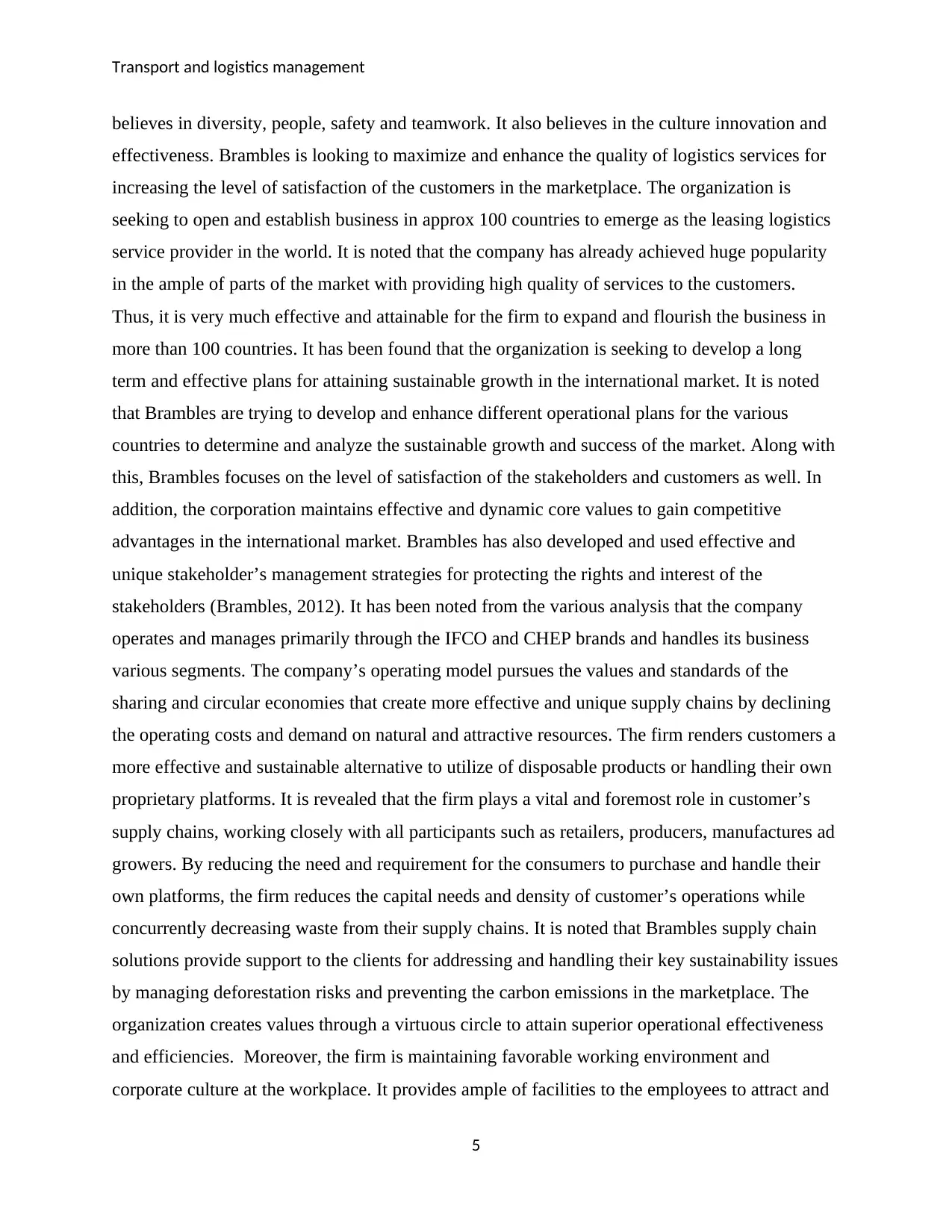
Transport and logistics management
believes in diversity, people, safety and teamwork. It also believes in the culture innovation and
effectiveness. Brambles is looking to maximize and enhance the quality of logistics services for
increasing the level of satisfaction of the customers in the marketplace. The organization is
seeking to open and establish business in approx 100 countries to emerge as the leasing logistics
service provider in the world. It is noted that the company has already achieved huge popularity
in the ample of parts of the market with providing high quality of services to the customers.
Thus, it is very much effective and attainable for the firm to expand and flourish the business in
more than 100 countries. It has been found that the organization is seeking to develop a long
term and effective plans for attaining sustainable growth in the international market. It is noted
that Brambles are trying to develop and enhance different operational plans for the various
countries to determine and analyze the sustainable growth and success of the market. Along with
this, Brambles focuses on the level of satisfaction of the stakeholders and customers as well. In
addition, the corporation maintains effective and dynamic core values to gain competitive
advantages in the international market. Brambles has also developed and used effective and
unique stakeholder’s management strategies for protecting the rights and interest of the
stakeholders (Brambles, 2012). It has been noted from the various analysis that the company
operates and manages primarily through the IFCO and CHEP brands and handles its business
various segments. The company’s operating model pursues the values and standards of the
sharing and circular economies that create more effective and unique supply chains by declining
the operating costs and demand on natural and attractive resources. The firm renders customers a
more effective and sustainable alternative to utilize of disposable products or handling their own
proprietary platforms. It is revealed that the firm plays a vital and foremost role in customer’s
supply chains, working closely with all participants such as retailers, producers, manufactures ad
growers. By reducing the need and requirement for the consumers to purchase and handle their
own platforms, the firm reduces the capital needs and density of customer’s operations while
concurrently decreasing waste from their supply chains. It is noted that Brambles supply chain
solutions provide support to the clients for addressing and handling their key sustainability issues
by managing deforestation risks and preventing the carbon emissions in the marketplace. The
organization creates values through a virtuous circle to attain superior operational effectiveness
and efficiencies. Moreover, the firm is maintaining favorable working environment and
corporate culture at the workplace. It provides ample of facilities to the employees to attract and
5
believes in diversity, people, safety and teamwork. It also believes in the culture innovation and
effectiveness. Brambles is looking to maximize and enhance the quality of logistics services for
increasing the level of satisfaction of the customers in the marketplace. The organization is
seeking to open and establish business in approx 100 countries to emerge as the leasing logistics
service provider in the world. It is noted that the company has already achieved huge popularity
in the ample of parts of the market with providing high quality of services to the customers.
Thus, it is very much effective and attainable for the firm to expand and flourish the business in
more than 100 countries. It has been found that the organization is seeking to develop a long
term and effective plans for attaining sustainable growth in the international market. It is noted
that Brambles are trying to develop and enhance different operational plans for the various
countries to determine and analyze the sustainable growth and success of the market. Along with
this, Brambles focuses on the level of satisfaction of the stakeholders and customers as well. In
addition, the corporation maintains effective and dynamic core values to gain competitive
advantages in the international market. Brambles has also developed and used effective and
unique stakeholder’s management strategies for protecting the rights and interest of the
stakeholders (Brambles, 2012). It has been noted from the various analysis that the company
operates and manages primarily through the IFCO and CHEP brands and handles its business
various segments. The company’s operating model pursues the values and standards of the
sharing and circular economies that create more effective and unique supply chains by declining
the operating costs and demand on natural and attractive resources. The firm renders customers a
more effective and sustainable alternative to utilize of disposable products or handling their own
proprietary platforms. It is revealed that the firm plays a vital and foremost role in customer’s
supply chains, working closely with all participants such as retailers, producers, manufactures ad
growers. By reducing the need and requirement for the consumers to purchase and handle their
own platforms, the firm reduces the capital needs and density of customer’s operations while
concurrently decreasing waste from their supply chains. It is noted that Brambles supply chain
solutions provide support to the clients for addressing and handling their key sustainability issues
by managing deforestation risks and preventing the carbon emissions in the marketplace. The
organization creates values through a virtuous circle to attain superior operational effectiveness
and efficiencies. Moreover, the firm is maintaining favorable working environment and
corporate culture at the workplace. It provides ample of facilities to the employees to attract and
5
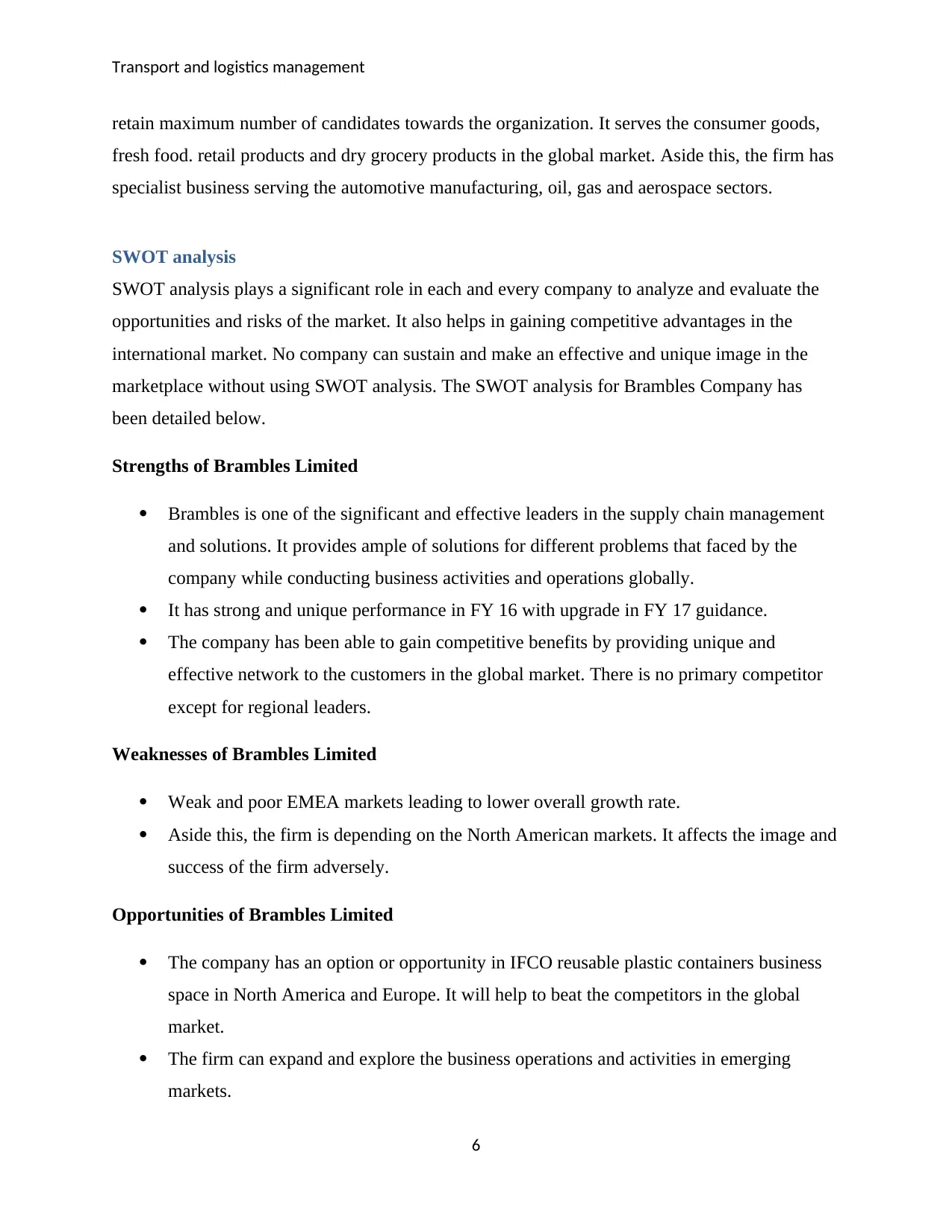
Transport and logistics management
retain maximum number of candidates towards the organization. It serves the consumer goods,
fresh food. retail products and dry grocery products in the global market. Aside this, the firm has
specialist business serving the automotive manufacturing, oil, gas and aerospace sectors.
SWOT analysis
SWOT analysis plays a significant role in each and every company to analyze and evaluate the
opportunities and risks of the market. It also helps in gaining competitive advantages in the
international market. No company can sustain and make an effective and unique image in the
marketplace without using SWOT analysis. The SWOT analysis for Brambles Company has
been detailed below.
Strengths of Brambles Limited
Brambles is one of the significant and effective leaders in the supply chain management
and solutions. It provides ample of solutions for different problems that faced by the
company while conducting business activities and operations globally.
It has strong and unique performance in FY 16 with upgrade in FY 17 guidance.
The company has been able to gain competitive benefits by providing unique and
effective network to the customers in the global market. There is no primary competitor
except for regional leaders.
Weaknesses of Brambles Limited
Weak and poor EMEA markets leading to lower overall growth rate.
Aside this, the firm is depending on the North American markets. It affects the image and
success of the firm adversely.
Opportunities of Brambles Limited
The company has an option or opportunity in IFCO reusable plastic containers business
space in North America and Europe. It will help to beat the competitors in the global
market.
The firm can expand and explore the business operations and activities in emerging
markets.
6
retain maximum number of candidates towards the organization. It serves the consumer goods,
fresh food. retail products and dry grocery products in the global market. Aside this, the firm has
specialist business serving the automotive manufacturing, oil, gas and aerospace sectors.
SWOT analysis
SWOT analysis plays a significant role in each and every company to analyze and evaluate the
opportunities and risks of the market. It also helps in gaining competitive advantages in the
international market. No company can sustain and make an effective and unique image in the
marketplace without using SWOT analysis. The SWOT analysis for Brambles Company has
been detailed below.
Strengths of Brambles Limited
Brambles is one of the significant and effective leaders in the supply chain management
and solutions. It provides ample of solutions for different problems that faced by the
company while conducting business activities and operations globally.
It has strong and unique performance in FY 16 with upgrade in FY 17 guidance.
The company has been able to gain competitive benefits by providing unique and
effective network to the customers in the global market. There is no primary competitor
except for regional leaders.
Weaknesses of Brambles Limited
Weak and poor EMEA markets leading to lower overall growth rate.
Aside this, the firm is depending on the North American markets. It affects the image and
success of the firm adversely.
Opportunities of Brambles Limited
The company has an option or opportunity in IFCO reusable plastic containers business
space in North America and Europe. It will help to beat the competitors in the global
market.
The firm can expand and explore the business operations and activities in emerging
markets.
6
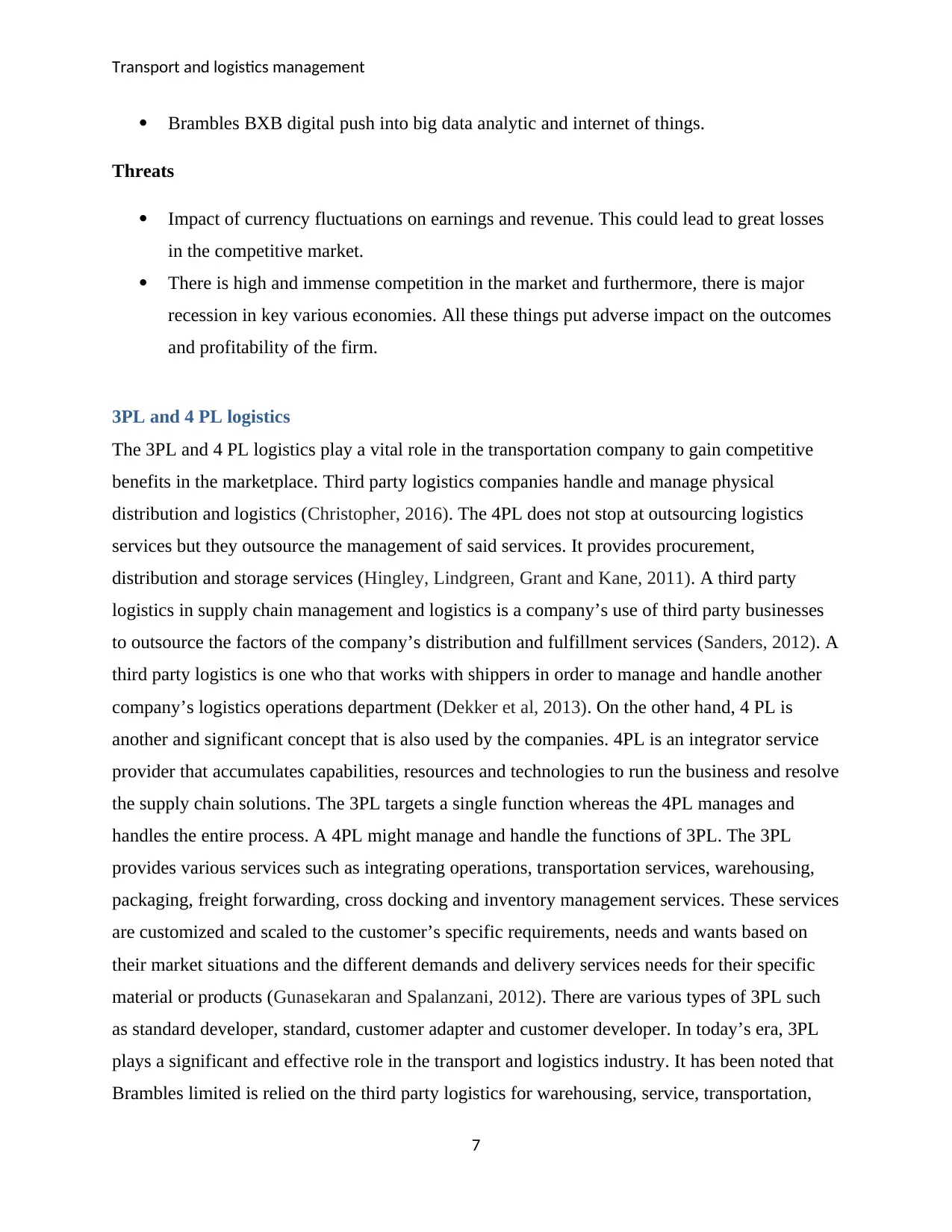
Transport and logistics management
Brambles BXB digital push into big data analytic and internet of things.
Threats
Impact of currency fluctuations on earnings and revenue. This could lead to great losses
in the competitive market.
There is high and immense competition in the market and furthermore, there is major
recession in key various economies. All these things put adverse impact on the outcomes
and profitability of the firm.
3PL and 4 PL logistics
The 3PL and 4 PL logistics play a vital role in the transportation company to gain competitive
benefits in the marketplace. Third party logistics companies handle and manage physical
distribution and logistics (Christopher, 2016). The 4PL does not stop at outsourcing logistics
services but they outsource the management of said services. It provides procurement,
distribution and storage services (Hingley, Lindgreen, Grant and Kane, 2011). A third party
logistics in supply chain management and logistics is a company’s use of third party businesses
to outsource the factors of the company’s distribution and fulfillment services (Sanders, 2012). A
third party logistics is one who that works with shippers in order to manage and handle another
company’s logistics operations department (Dekker et al, 2013). On the other hand, 4 PL is
another and significant concept that is also used by the companies. 4PL is an integrator service
provider that accumulates capabilities, resources and technologies to run the business and resolve
the supply chain solutions. The 3PL targets a single function whereas the 4PL manages and
handles the entire process. A 4PL might manage and handle the functions of 3PL. The 3PL
provides various services such as integrating operations, transportation services, warehousing,
packaging, freight forwarding, cross docking and inventory management services. These services
are customized and scaled to the customer’s specific requirements, needs and wants based on
their market situations and the different demands and delivery services needs for their specific
material or products (Gunasekaran and Spalanzani, 2012). There are various types of 3PL such
as standard developer, standard, customer adapter and customer developer. In today’s era, 3PL
plays a significant and effective role in the transport and logistics industry. It has been noted that
Brambles limited is relied on the third party logistics for warehousing, service, transportation,
7
Brambles BXB digital push into big data analytic and internet of things.
Threats
Impact of currency fluctuations on earnings and revenue. This could lead to great losses
in the competitive market.
There is high and immense competition in the market and furthermore, there is major
recession in key various economies. All these things put adverse impact on the outcomes
and profitability of the firm.
3PL and 4 PL logistics
The 3PL and 4 PL logistics play a vital role in the transportation company to gain competitive
benefits in the marketplace. Third party logistics companies handle and manage physical
distribution and logistics (Christopher, 2016). The 4PL does not stop at outsourcing logistics
services but they outsource the management of said services. It provides procurement,
distribution and storage services (Hingley, Lindgreen, Grant and Kane, 2011). A third party
logistics in supply chain management and logistics is a company’s use of third party businesses
to outsource the factors of the company’s distribution and fulfillment services (Sanders, 2012). A
third party logistics is one who that works with shippers in order to manage and handle another
company’s logistics operations department (Dekker et al, 2013). On the other hand, 4 PL is
another and significant concept that is also used by the companies. 4PL is an integrator service
provider that accumulates capabilities, resources and technologies to run the business and resolve
the supply chain solutions. The 3PL targets a single function whereas the 4PL manages and
handles the entire process. A 4PL might manage and handle the functions of 3PL. The 3PL
provides various services such as integrating operations, transportation services, warehousing,
packaging, freight forwarding, cross docking and inventory management services. These services
are customized and scaled to the customer’s specific requirements, needs and wants based on
their market situations and the different demands and delivery services needs for their specific
material or products (Gunasekaran and Spalanzani, 2012). There are various types of 3PL such
as standard developer, standard, customer adapter and customer developer. In today’s era, 3PL
plays a significant and effective role in the transport and logistics industry. It has been noted that
Brambles limited is relied on the third party logistics for warehousing, service, transportation,
7
Paraphrase This Document
Need a fresh take? Get an instant paraphrase of this document with our AI Paraphraser
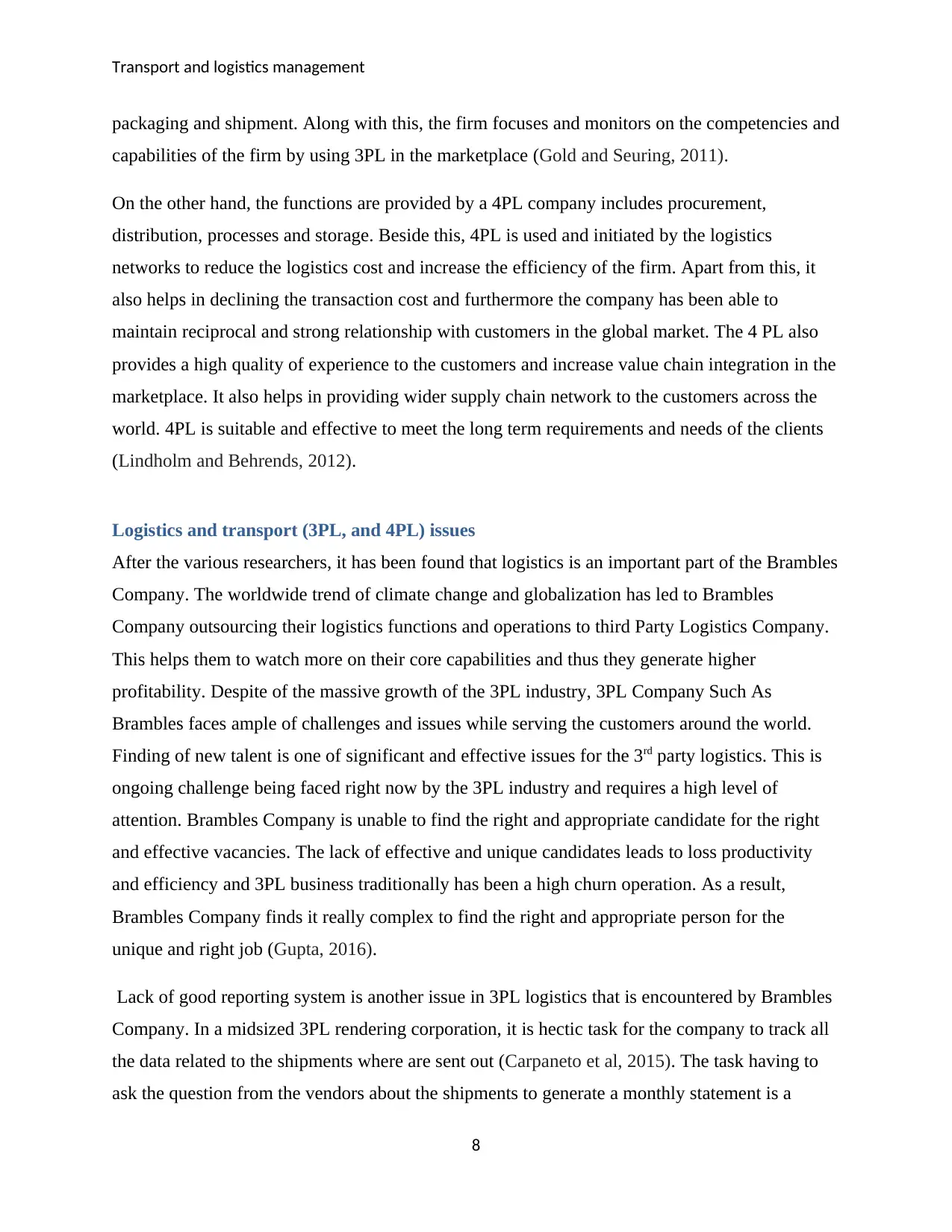
Transport and logistics management
packaging and shipment. Along with this, the firm focuses and monitors on the competencies and
capabilities of the firm by using 3PL in the marketplace (Gold and Seuring, 2011).
On the other hand, the functions are provided by a 4PL company includes procurement,
distribution, processes and storage. Beside this, 4PL is used and initiated by the logistics
networks to reduce the logistics cost and increase the efficiency of the firm. Apart from this, it
also helps in declining the transaction cost and furthermore the company has been able to
maintain reciprocal and strong relationship with customers in the global market. The 4 PL also
provides a high quality of experience to the customers and increase value chain integration in the
marketplace. It also helps in providing wider supply chain network to the customers across the
world. 4PL is suitable and effective to meet the long term requirements and needs of the clients
(Lindholm and Behrends, 2012).
Logistics and transport (3PL, and 4PL) issues
After the various researchers, it has been found that logistics is an important part of the Brambles
Company. The worldwide trend of climate change and globalization has led to Brambles
Company outsourcing their logistics functions and operations to third Party Logistics Company.
This helps them to watch more on their core capabilities and thus they generate higher
profitability. Despite of the massive growth of the 3PL industry, 3PL Company Such As
Brambles faces ample of challenges and issues while serving the customers around the world.
Finding of new talent is one of significant and effective issues for the 3rd party logistics. This is
ongoing challenge being faced right now by the 3PL industry and requires a high level of
attention. Brambles Company is unable to find the right and appropriate candidate for the right
and effective vacancies. The lack of effective and unique candidates leads to loss productivity
and efficiency and 3PL business traditionally has been a high churn operation. As a result,
Brambles Company finds it really complex to find the right and appropriate person for the
unique and right job (Gupta, 2016).
Lack of good reporting system is another issue in 3PL logistics that is encountered by Brambles
Company. In a midsized 3PL rendering corporation, it is hectic task for the company to track all
the data related to the shipments where are sent out (Carpaneto et al, 2015). The task having to
ask the question from the vendors about the shipments to generate a monthly statement is a
8
packaging and shipment. Along with this, the firm focuses and monitors on the competencies and
capabilities of the firm by using 3PL in the marketplace (Gold and Seuring, 2011).
On the other hand, the functions are provided by a 4PL company includes procurement,
distribution, processes and storage. Beside this, 4PL is used and initiated by the logistics
networks to reduce the logistics cost and increase the efficiency of the firm. Apart from this, it
also helps in declining the transaction cost and furthermore the company has been able to
maintain reciprocal and strong relationship with customers in the global market. The 4 PL also
provides a high quality of experience to the customers and increase value chain integration in the
marketplace. It also helps in providing wider supply chain network to the customers across the
world. 4PL is suitable and effective to meet the long term requirements and needs of the clients
(Lindholm and Behrends, 2012).
Logistics and transport (3PL, and 4PL) issues
After the various researchers, it has been found that logistics is an important part of the Brambles
Company. The worldwide trend of climate change and globalization has led to Brambles
Company outsourcing their logistics functions and operations to third Party Logistics Company.
This helps them to watch more on their core capabilities and thus they generate higher
profitability. Despite of the massive growth of the 3PL industry, 3PL Company Such As
Brambles faces ample of challenges and issues while serving the customers around the world.
Finding of new talent is one of significant and effective issues for the 3rd party logistics. This is
ongoing challenge being faced right now by the 3PL industry and requires a high level of
attention. Brambles Company is unable to find the right and appropriate candidate for the right
and effective vacancies. The lack of effective and unique candidates leads to loss productivity
and efficiency and 3PL business traditionally has been a high churn operation. As a result,
Brambles Company finds it really complex to find the right and appropriate person for the
unique and right job (Gupta, 2016).
Lack of good reporting system is another issue in 3PL logistics that is encountered by Brambles
Company. In a midsized 3PL rendering corporation, it is hectic task for the company to track all
the data related to the shipments where are sent out (Carpaneto et al, 2015). The task having to
ask the question from the vendors about the shipments to generate a monthly statement is a
8
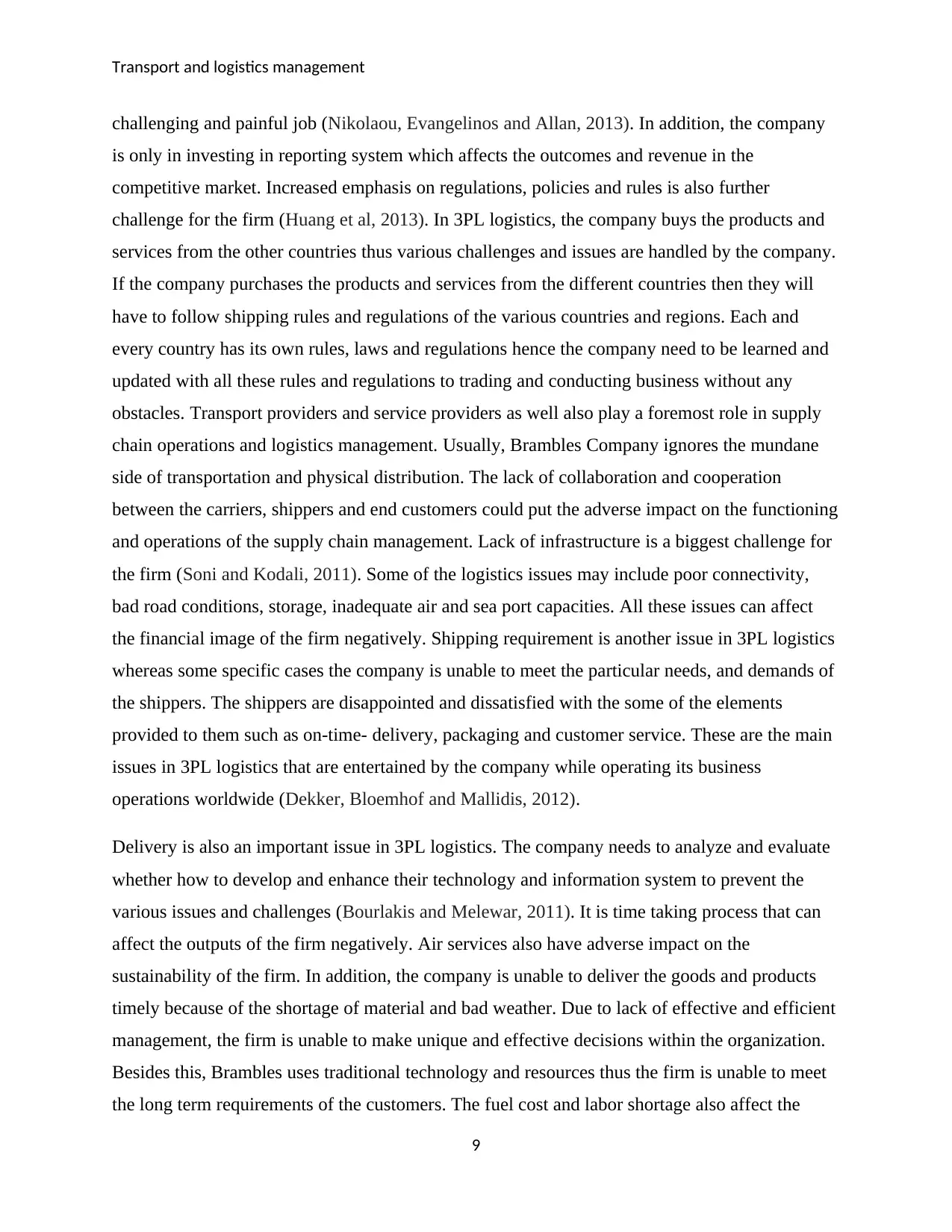
Transport and logistics management
challenging and painful job (Nikolaou, Evangelinos and Allan, 2013). In addition, the company
is only in investing in reporting system which affects the outcomes and revenue in the
competitive market. Increased emphasis on regulations, policies and rules is also further
challenge for the firm (Huang et al, 2013). In 3PL logistics, the company buys the products and
services from the other countries thus various challenges and issues are handled by the company.
If the company purchases the products and services from the different countries then they will
have to follow shipping rules and regulations of the various countries and regions. Each and
every country has its own rules, laws and regulations hence the company need to be learned and
updated with all these rules and regulations to trading and conducting business without any
obstacles. Transport providers and service providers as well also play a foremost role in supply
chain operations and logistics management. Usually, Brambles Company ignores the mundane
side of transportation and physical distribution. The lack of collaboration and cooperation
between the carriers, shippers and end customers could put the adverse impact on the functioning
and operations of the supply chain management. Lack of infrastructure is a biggest challenge for
the firm (Soni and Kodali, 2011). Some of the logistics issues may include poor connectivity,
bad road conditions, storage, inadequate air and sea port capacities. All these issues can affect
the financial image of the firm negatively. Shipping requirement is another issue in 3PL logistics
whereas some specific cases the company is unable to meet the particular needs, and demands of
the shippers. The shippers are disappointed and dissatisfied with the some of the elements
provided to them such as on-time- delivery, packaging and customer service. These are the main
issues in 3PL logistics that are entertained by the company while operating its business
operations worldwide (Dekker, Bloemhof and Mallidis, 2012).
Delivery is also an important issue in 3PL logistics. The company needs to analyze and evaluate
whether how to develop and enhance their technology and information system to prevent the
various issues and challenges (Bourlakis and Melewar, 2011). It is time taking process that can
affect the outputs of the firm negatively. Air services also have adverse impact on the
sustainability of the firm. In addition, the company is unable to deliver the goods and products
timely because of the shortage of material and bad weather. Due to lack of effective and efficient
management, the firm is unable to make unique and effective decisions within the organization.
Besides this, Brambles uses traditional technology and resources thus the firm is unable to meet
the long term requirements of the customers. The fuel cost and labor shortage also affect the
9
challenging and painful job (Nikolaou, Evangelinos and Allan, 2013). In addition, the company
is only in investing in reporting system which affects the outcomes and revenue in the
competitive market. Increased emphasis on regulations, policies and rules is also further
challenge for the firm (Huang et al, 2013). In 3PL logistics, the company buys the products and
services from the other countries thus various challenges and issues are handled by the company.
If the company purchases the products and services from the different countries then they will
have to follow shipping rules and regulations of the various countries and regions. Each and
every country has its own rules, laws and regulations hence the company need to be learned and
updated with all these rules and regulations to trading and conducting business without any
obstacles. Transport providers and service providers as well also play a foremost role in supply
chain operations and logistics management. Usually, Brambles Company ignores the mundane
side of transportation and physical distribution. The lack of collaboration and cooperation
between the carriers, shippers and end customers could put the adverse impact on the functioning
and operations of the supply chain management. Lack of infrastructure is a biggest challenge for
the firm (Soni and Kodali, 2011). Some of the logistics issues may include poor connectivity,
bad road conditions, storage, inadequate air and sea port capacities. All these issues can affect
the financial image of the firm negatively. Shipping requirement is another issue in 3PL logistics
whereas some specific cases the company is unable to meet the particular needs, and demands of
the shippers. The shippers are disappointed and dissatisfied with the some of the elements
provided to them such as on-time- delivery, packaging and customer service. These are the main
issues in 3PL logistics that are entertained by the company while operating its business
operations worldwide (Dekker, Bloemhof and Mallidis, 2012).
Delivery is also an important issue in 3PL logistics. The company needs to analyze and evaluate
whether how to develop and enhance their technology and information system to prevent the
various issues and challenges (Bourlakis and Melewar, 2011). It is time taking process that can
affect the outputs of the firm negatively. Air services also have adverse impact on the
sustainability of the firm. In addition, the company is unable to deliver the goods and products
timely because of the shortage of material and bad weather. Due to lack of effective and efficient
management, the firm is unable to make unique and effective decisions within the organization.
Besides this, Brambles uses traditional technology and resources thus the firm is unable to meet
the long term requirements of the customers. The fuel cost and labor shortage also affect the
9
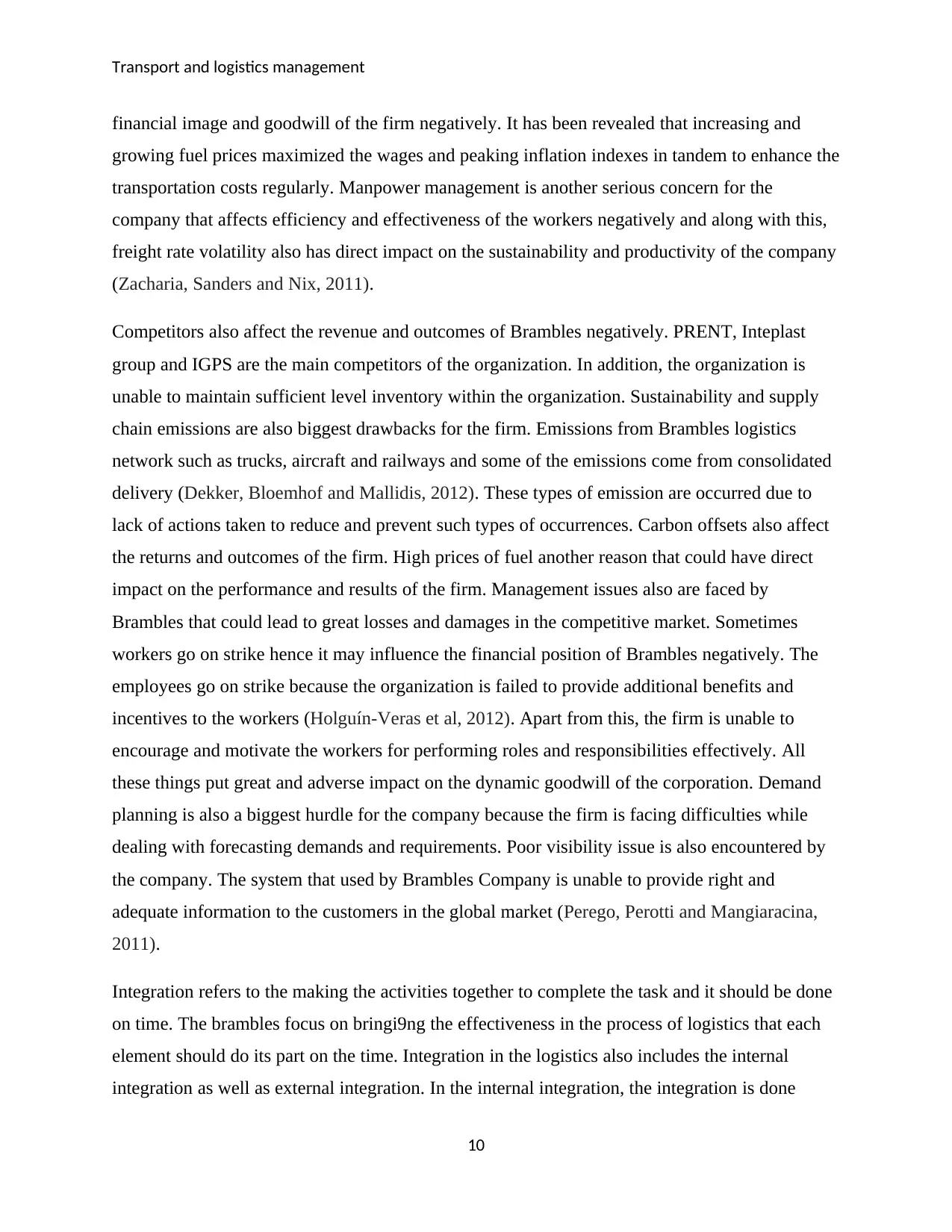
Transport and logistics management
financial image and goodwill of the firm negatively. It has been revealed that increasing and
growing fuel prices maximized the wages and peaking inflation indexes in tandem to enhance the
transportation costs regularly. Manpower management is another serious concern for the
company that affects efficiency and effectiveness of the workers negatively and along with this,
freight rate volatility also has direct impact on the sustainability and productivity of the company
(Zacharia, Sanders and Nix, 2011).
Competitors also affect the revenue and outcomes of Brambles negatively. PRENT, Inteplast
group and IGPS are the main competitors of the organization. In addition, the organization is
unable to maintain sufficient level inventory within the organization. Sustainability and supply
chain emissions are also biggest drawbacks for the firm. Emissions from Brambles logistics
network such as trucks, aircraft and railways and some of the emissions come from consolidated
delivery (Dekker, Bloemhof and Mallidis, 2012). These types of emission are occurred due to
lack of actions taken to reduce and prevent such types of occurrences. Carbon offsets also affect
the returns and outcomes of the firm. High prices of fuel another reason that could have direct
impact on the performance and results of the firm. Management issues also are faced by
Brambles that could lead to great losses and damages in the competitive market. Sometimes
workers go on strike hence it may influence the financial position of Brambles negatively. The
employees go on strike because the organization is failed to provide additional benefits and
incentives to the workers (Holguín-Veras et al, 2012). Apart from this, the firm is unable to
encourage and motivate the workers for performing roles and responsibilities effectively. All
these things put great and adverse impact on the dynamic goodwill of the corporation. Demand
planning is also a biggest hurdle for the company because the firm is facing difficulties while
dealing with forecasting demands and requirements. Poor visibility issue is also encountered by
the company. The system that used by Brambles Company is unable to provide right and
adequate information to the customers in the global market (Perego, Perotti and Mangiaracina,
2011).
Integration refers to the making the activities together to complete the task and it should be done
on time. The brambles focus on bringi9ng the effectiveness in the process of logistics that each
element should do its part on the time. Integration in the logistics also includes the internal
integration as well as external integration. In the internal integration, the integration is done
10
financial image and goodwill of the firm negatively. It has been revealed that increasing and
growing fuel prices maximized the wages and peaking inflation indexes in tandem to enhance the
transportation costs regularly. Manpower management is another serious concern for the
company that affects efficiency and effectiveness of the workers negatively and along with this,
freight rate volatility also has direct impact on the sustainability and productivity of the company
(Zacharia, Sanders and Nix, 2011).
Competitors also affect the revenue and outcomes of Brambles negatively. PRENT, Inteplast
group and IGPS are the main competitors of the organization. In addition, the organization is
unable to maintain sufficient level inventory within the organization. Sustainability and supply
chain emissions are also biggest drawbacks for the firm. Emissions from Brambles logistics
network such as trucks, aircraft and railways and some of the emissions come from consolidated
delivery (Dekker, Bloemhof and Mallidis, 2012). These types of emission are occurred due to
lack of actions taken to reduce and prevent such types of occurrences. Carbon offsets also affect
the returns and outcomes of the firm. High prices of fuel another reason that could have direct
impact on the performance and results of the firm. Management issues also are faced by
Brambles that could lead to great losses and damages in the competitive market. Sometimes
workers go on strike hence it may influence the financial position of Brambles negatively. The
employees go on strike because the organization is failed to provide additional benefits and
incentives to the workers (Holguín-Veras et al, 2012). Apart from this, the firm is unable to
encourage and motivate the workers for performing roles and responsibilities effectively. All
these things put great and adverse impact on the dynamic goodwill of the corporation. Demand
planning is also a biggest hurdle for the company because the firm is facing difficulties while
dealing with forecasting demands and requirements. Poor visibility issue is also encountered by
the company. The system that used by Brambles Company is unable to provide right and
adequate information to the customers in the global market (Perego, Perotti and Mangiaracina,
2011).
Integration refers to the making the activities together to complete the task and it should be done
on time. The brambles focus on bringi9ng the effectiveness in the process of logistics that each
element should do its part on the time. Integration in the logistics also includes the internal
integration as well as external integration. In the internal integration, the integration is done
10
Secure Best Marks with AI Grader
Need help grading? Try our AI Grader for instant feedback on your assignments.
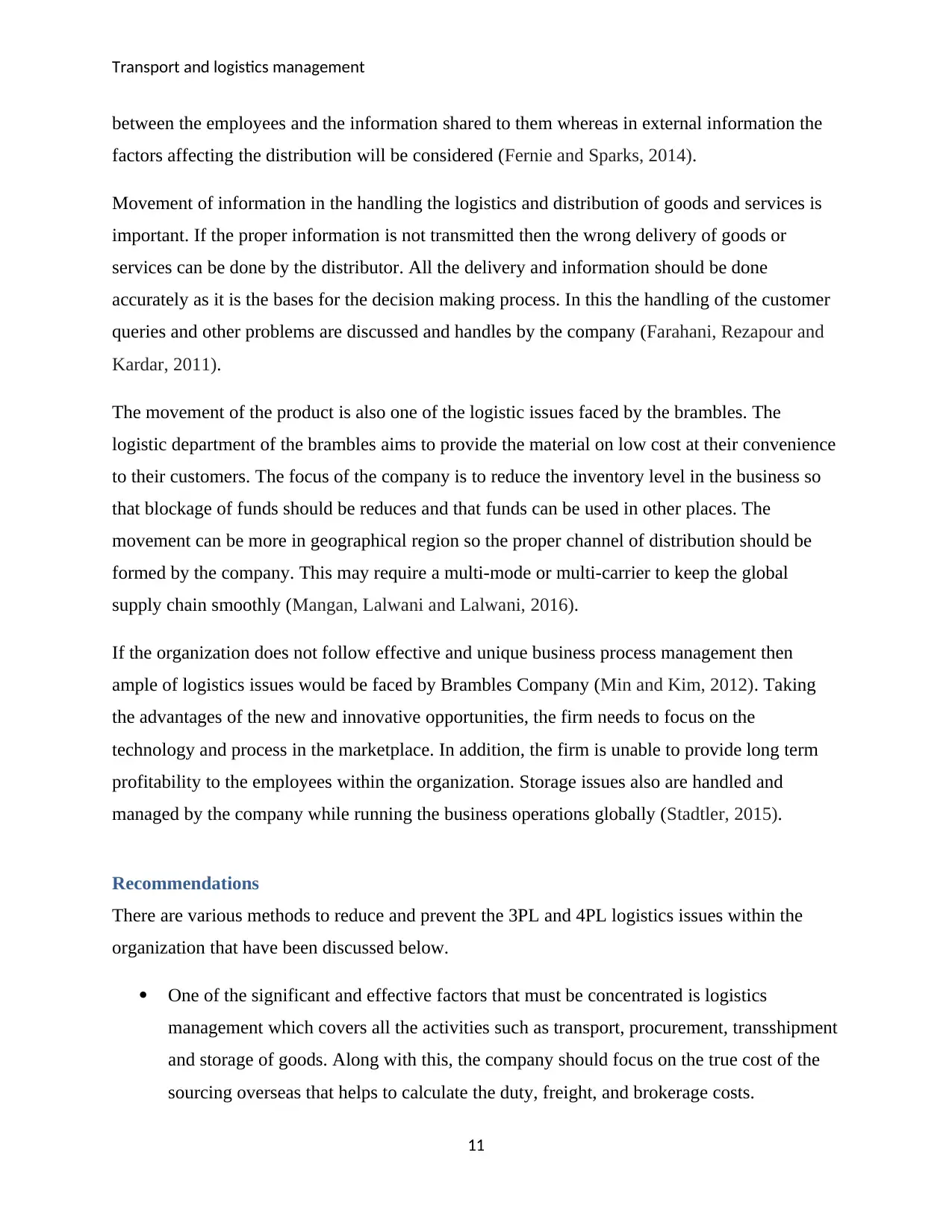
Transport and logistics management
between the employees and the information shared to them whereas in external information the
factors affecting the distribution will be considered (Fernie and Sparks, 2014).
Movement of information in the handling the logistics and distribution of goods and services is
important. If the proper information is not transmitted then the wrong delivery of goods or
services can be done by the distributor. All the delivery and information should be done
accurately as it is the bases for the decision making process. In this the handling of the customer
queries and other problems are discussed and handles by the company (Farahani, Rezapour and
Kardar, 2011).
The movement of the product is also one of the logistic issues faced by the brambles. The
logistic department of the brambles aims to provide the material on low cost at their convenience
to their customers. The focus of the company is to reduce the inventory level in the business so
that blockage of funds should be reduces and that funds can be used in other places. The
movement can be more in geographical region so the proper channel of distribution should be
formed by the company. This may require a multi-mode or multi-carrier to keep the global
supply chain smoothly (Mangan, Lalwani and Lalwani, 2016).
If the organization does not follow effective and unique business process management then
ample of logistics issues would be faced by Brambles Company (Min and Kim, 2012). Taking
the advantages of the new and innovative opportunities, the firm needs to focus on the
technology and process in the marketplace. In addition, the firm is unable to provide long term
profitability to the employees within the organization. Storage issues also are handled and
managed by the company while running the business operations globally (Stadtler, 2015).
Recommendations
There are various methods to reduce and prevent the 3PL and 4PL logistics issues within the
organization that have been discussed below.
One of the significant and effective factors that must be concentrated is logistics
management which covers all the activities such as transport, procurement, transshipment
and storage of goods. Along with this, the company should focus on the true cost of the
sourcing overseas that helps to calculate the duty, freight, and brokerage costs.
11
between the employees and the information shared to them whereas in external information the
factors affecting the distribution will be considered (Fernie and Sparks, 2014).
Movement of information in the handling the logistics and distribution of goods and services is
important. If the proper information is not transmitted then the wrong delivery of goods or
services can be done by the distributor. All the delivery and information should be done
accurately as it is the bases for the decision making process. In this the handling of the customer
queries and other problems are discussed and handles by the company (Farahani, Rezapour and
Kardar, 2011).
The movement of the product is also one of the logistic issues faced by the brambles. The
logistic department of the brambles aims to provide the material on low cost at their convenience
to their customers. The focus of the company is to reduce the inventory level in the business so
that blockage of funds should be reduces and that funds can be used in other places. The
movement can be more in geographical region so the proper channel of distribution should be
formed by the company. This may require a multi-mode or multi-carrier to keep the global
supply chain smoothly (Mangan, Lalwani and Lalwani, 2016).
If the organization does not follow effective and unique business process management then
ample of logistics issues would be faced by Brambles Company (Min and Kim, 2012). Taking
the advantages of the new and innovative opportunities, the firm needs to focus on the
technology and process in the marketplace. In addition, the firm is unable to provide long term
profitability to the employees within the organization. Storage issues also are handled and
managed by the company while running the business operations globally (Stadtler, 2015).
Recommendations
There are various methods to reduce and prevent the 3PL and 4PL logistics issues within the
organization that have been discussed below.
One of the significant and effective factors that must be concentrated is logistics
management which covers all the activities such as transport, procurement, transshipment
and storage of goods. Along with this, the company should focus on the true cost of the
sourcing overseas that helps to calculate the duty, freight, and brokerage costs.
11
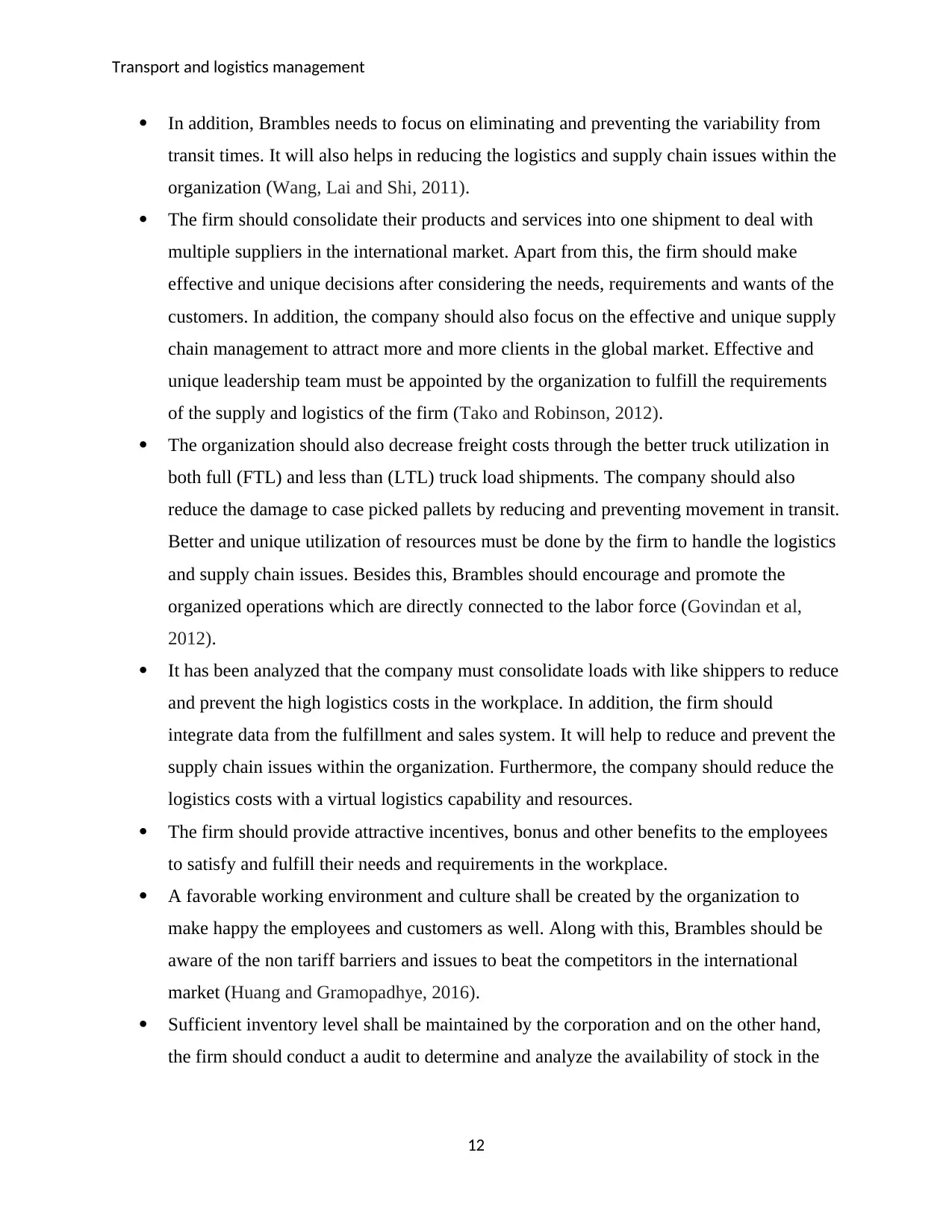
Transport and logistics management
In addition, Brambles needs to focus on eliminating and preventing the variability from
transit times. It will also helps in reducing the logistics and supply chain issues within the
organization (Wang, Lai and Shi, 2011).
The firm should consolidate their products and services into one shipment to deal with
multiple suppliers in the international market. Apart from this, the firm should make
effective and unique decisions after considering the needs, requirements and wants of the
customers. In addition, the company should also focus on the effective and unique supply
chain management to attract more and more clients in the global market. Effective and
unique leadership team must be appointed by the organization to fulfill the requirements
of the supply and logistics of the firm (Tako and Robinson, 2012).
The organization should also decrease freight costs through the better truck utilization in
both full (FTL) and less than (LTL) truck load shipments. The company should also
reduce the damage to case picked pallets by reducing and preventing movement in transit.
Better and unique utilization of resources must be done by the firm to handle the logistics
and supply chain issues. Besides this, Brambles should encourage and promote the
organized operations which are directly connected to the labor force (Govindan et al,
2012).
It has been analyzed that the company must consolidate loads with like shippers to reduce
and prevent the high logistics costs in the workplace. In addition, the firm should
integrate data from the fulfillment and sales system. It will help to reduce and prevent the
supply chain issues within the organization. Furthermore, the company should reduce the
logistics costs with a virtual logistics capability and resources.
The firm should provide attractive incentives, bonus and other benefits to the employees
to satisfy and fulfill their needs and requirements in the workplace.
A favorable working environment and culture shall be created by the organization to
make happy the employees and customers as well. Along with this, Brambles should be
aware of the non tariff barriers and issues to beat the competitors in the international
market (Huang and Gramopadhye, 2016).
Sufficient inventory level shall be maintained by the corporation and on the other hand,
the firm should conduct a audit to determine and analyze the availability of stock in the
12
In addition, Brambles needs to focus on eliminating and preventing the variability from
transit times. It will also helps in reducing the logistics and supply chain issues within the
organization (Wang, Lai and Shi, 2011).
The firm should consolidate their products and services into one shipment to deal with
multiple suppliers in the international market. Apart from this, the firm should make
effective and unique decisions after considering the needs, requirements and wants of the
customers. In addition, the company should also focus on the effective and unique supply
chain management to attract more and more clients in the global market. Effective and
unique leadership team must be appointed by the organization to fulfill the requirements
of the supply and logistics of the firm (Tako and Robinson, 2012).
The organization should also decrease freight costs through the better truck utilization in
both full (FTL) and less than (LTL) truck load shipments. The company should also
reduce the damage to case picked pallets by reducing and preventing movement in transit.
Better and unique utilization of resources must be done by the firm to handle the logistics
and supply chain issues. Besides this, Brambles should encourage and promote the
organized operations which are directly connected to the labor force (Govindan et al,
2012).
It has been analyzed that the company must consolidate loads with like shippers to reduce
and prevent the high logistics costs in the workplace. In addition, the firm should
integrate data from the fulfillment and sales system. It will help to reduce and prevent the
supply chain issues within the organization. Furthermore, the company should reduce the
logistics costs with a virtual logistics capability and resources.
The firm should provide attractive incentives, bonus and other benefits to the employees
to satisfy and fulfill their needs and requirements in the workplace.
A favorable working environment and culture shall be created by the organization to
make happy the employees and customers as well. Along with this, Brambles should be
aware of the non tariff barriers and issues to beat the competitors in the international
market (Huang and Gramopadhye, 2016).
Sufficient inventory level shall be maintained by the corporation and on the other hand,
the firm should conduct a audit to determine and analyze the availability of stock in the
12
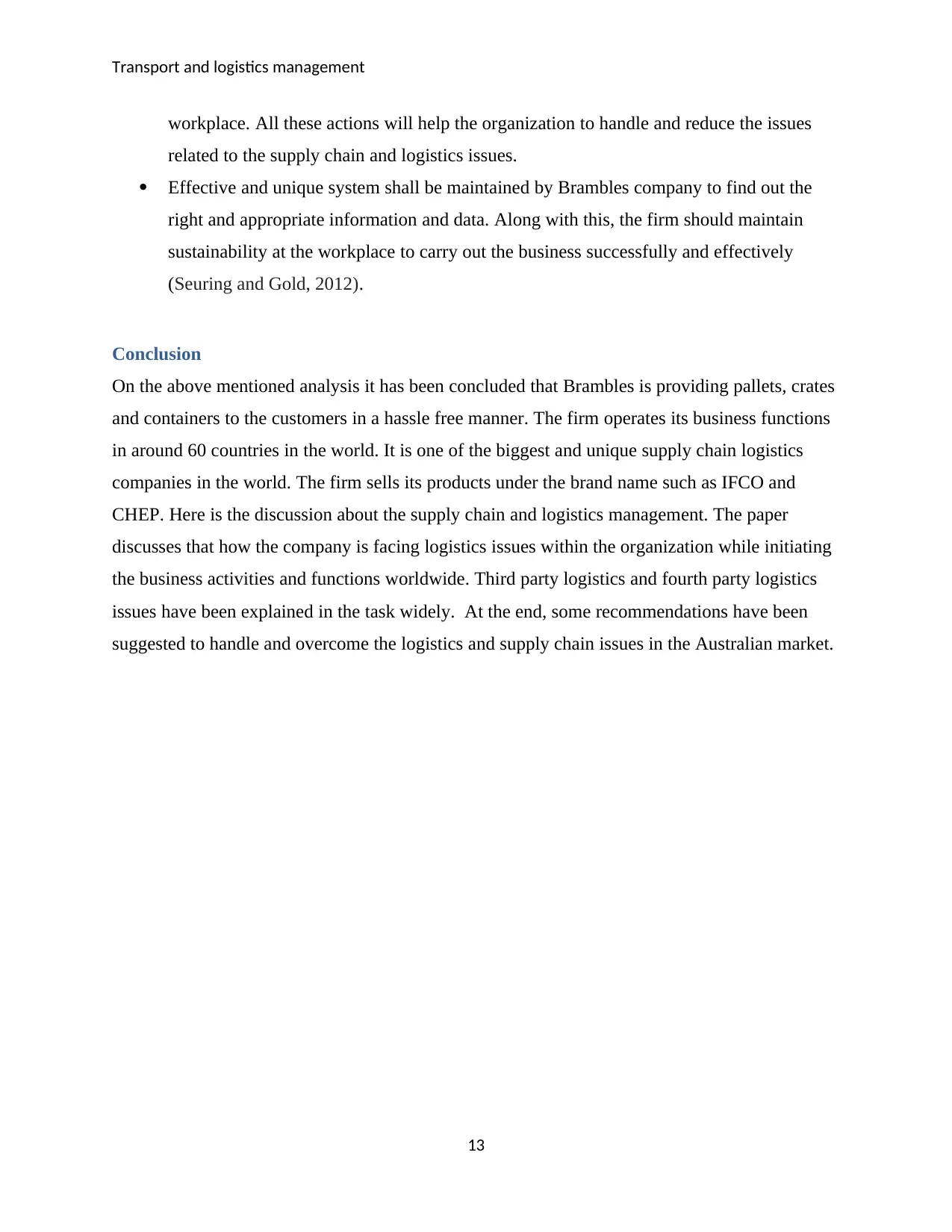
Transport and logistics management
workplace. All these actions will help the organization to handle and reduce the issues
related to the supply chain and logistics issues.
Effective and unique system shall be maintained by Brambles company to find out the
right and appropriate information and data. Along with this, the firm should maintain
sustainability at the workplace to carry out the business successfully and effectively
(Seuring and Gold, 2012).
Conclusion
On the above mentioned analysis it has been concluded that Brambles is providing pallets, crates
and containers to the customers in a hassle free manner. The firm operates its business functions
in around 60 countries in the world. It is one of the biggest and unique supply chain logistics
companies in the world. The firm sells its products under the brand name such as IFCO and
CHEP. Here is the discussion about the supply chain and logistics management. The paper
discusses that how the company is facing logistics issues within the organization while initiating
the business activities and functions worldwide. Third party logistics and fourth party logistics
issues have been explained in the task widely. At the end, some recommendations have been
suggested to handle and overcome the logistics and supply chain issues in the Australian market.
13
workplace. All these actions will help the organization to handle and reduce the issues
related to the supply chain and logistics issues.
Effective and unique system shall be maintained by Brambles company to find out the
right and appropriate information and data. Along with this, the firm should maintain
sustainability at the workplace to carry out the business successfully and effectively
(Seuring and Gold, 2012).
Conclusion
On the above mentioned analysis it has been concluded that Brambles is providing pallets, crates
and containers to the customers in a hassle free manner. The firm operates its business functions
in around 60 countries in the world. It is one of the biggest and unique supply chain logistics
companies in the world. The firm sells its products under the brand name such as IFCO and
CHEP. Here is the discussion about the supply chain and logistics management. The paper
discusses that how the company is facing logistics issues within the organization while initiating
the business activities and functions worldwide. Third party logistics and fourth party logistics
issues have been explained in the task widely. At the end, some recommendations have been
suggested to handle and overcome the logistics and supply chain issues in the Australian market.
13
Paraphrase This Document
Need a fresh take? Get an instant paraphrase of this document with our AI Paraphraser
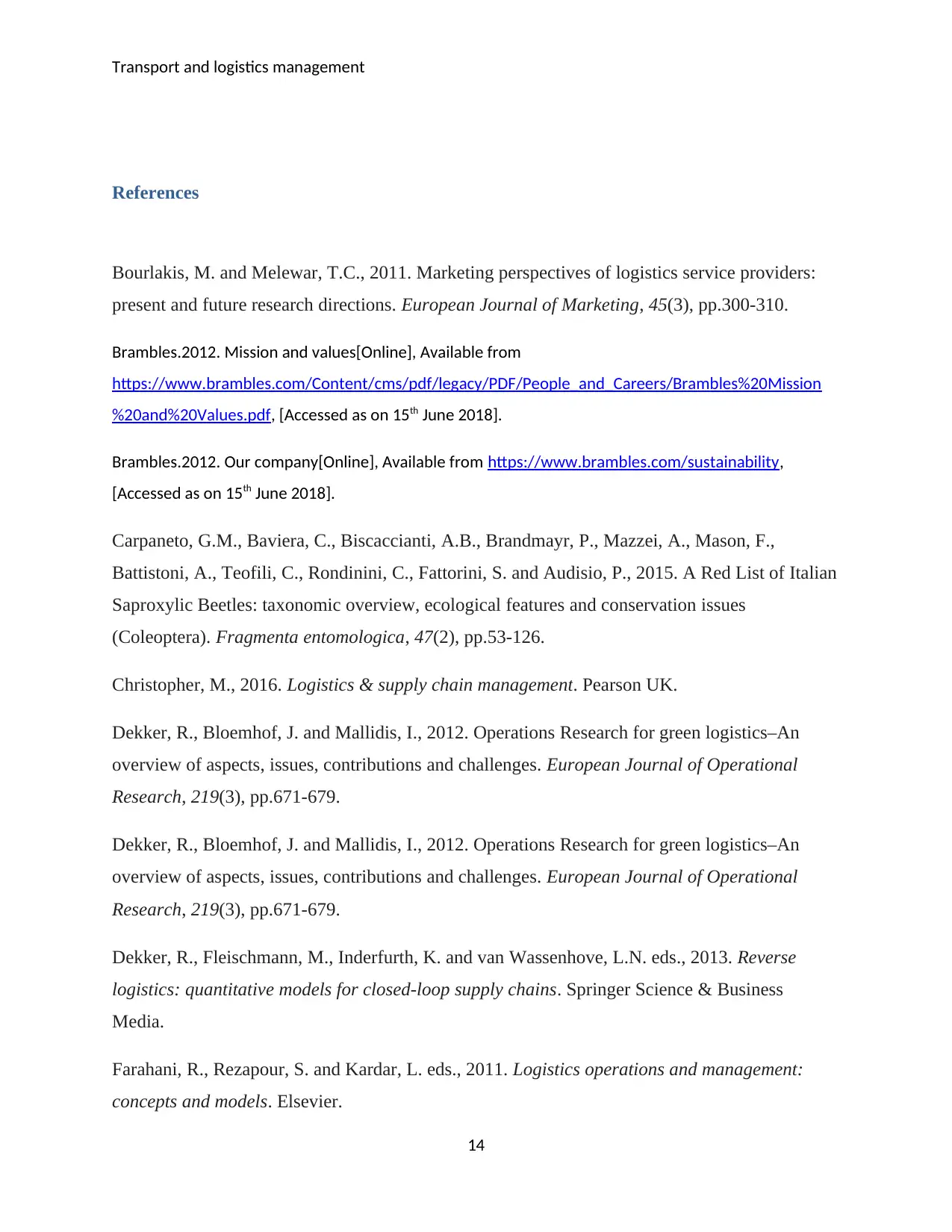
Transport and logistics management
References
Bourlakis, M. and Melewar, T.C., 2011. Marketing perspectives of logistics service providers:
present and future research directions. European Journal of Marketing, 45(3), pp.300-310.
Brambles.2012. Mission and values[Online], Available from
https://www.brambles.com/Content/cms/pdf/legacy/PDF/People_and_Careers/Brambles%20Mission
%20and%20Values.pdf, [Accessed as on 15th June 2018].
Brambles.2012. Our company[Online], Available from https://www.brambles.com/sustainability,
[Accessed as on 15th June 2018].
Carpaneto, G.M., Baviera, C., Biscaccianti, A.B., Brandmayr, P., Mazzei, A., Mason, F.,
Battistoni, A., Teofili, C., Rondinini, C., Fattorini, S. and Audisio, P., 2015. A Red List of Italian
Saproxylic Beetles: taxonomic overview, ecological features and conservation issues
(Coleoptera). Fragmenta entomologica, 47(2), pp.53-126.
Christopher, M., 2016. Logistics & supply chain management. Pearson UK.
Dekker, R., Bloemhof, J. and Mallidis, I., 2012. Operations Research for green logistics–An
overview of aspects, issues, contributions and challenges. European Journal of Operational
Research, 219(3), pp.671-679.
Dekker, R., Bloemhof, J. and Mallidis, I., 2012. Operations Research for green logistics–An
overview of aspects, issues, contributions and challenges. European Journal of Operational
Research, 219(3), pp.671-679.
Dekker, R., Fleischmann, M., Inderfurth, K. and van Wassenhove, L.N. eds., 2013. Reverse
logistics: quantitative models for closed-loop supply chains. Springer Science & Business
Media.
Farahani, R., Rezapour, S. and Kardar, L. eds., 2011. Logistics operations and management:
concepts and models. Elsevier.
14
References
Bourlakis, M. and Melewar, T.C., 2011. Marketing perspectives of logistics service providers:
present and future research directions. European Journal of Marketing, 45(3), pp.300-310.
Brambles.2012. Mission and values[Online], Available from
https://www.brambles.com/Content/cms/pdf/legacy/PDF/People_and_Careers/Brambles%20Mission
%20and%20Values.pdf, [Accessed as on 15th June 2018].
Brambles.2012. Our company[Online], Available from https://www.brambles.com/sustainability,
[Accessed as on 15th June 2018].
Carpaneto, G.M., Baviera, C., Biscaccianti, A.B., Brandmayr, P., Mazzei, A., Mason, F.,
Battistoni, A., Teofili, C., Rondinini, C., Fattorini, S. and Audisio, P., 2015. A Red List of Italian
Saproxylic Beetles: taxonomic overview, ecological features and conservation issues
(Coleoptera). Fragmenta entomologica, 47(2), pp.53-126.
Christopher, M., 2016. Logistics & supply chain management. Pearson UK.
Dekker, R., Bloemhof, J. and Mallidis, I., 2012. Operations Research for green logistics–An
overview of aspects, issues, contributions and challenges. European Journal of Operational
Research, 219(3), pp.671-679.
Dekker, R., Bloemhof, J. and Mallidis, I., 2012. Operations Research for green logistics–An
overview of aspects, issues, contributions and challenges. European Journal of Operational
Research, 219(3), pp.671-679.
Dekker, R., Fleischmann, M., Inderfurth, K. and van Wassenhove, L.N. eds., 2013. Reverse
logistics: quantitative models for closed-loop supply chains. Springer Science & Business
Media.
Farahani, R., Rezapour, S. and Kardar, L. eds., 2011. Logistics operations and management:
concepts and models. Elsevier.
14
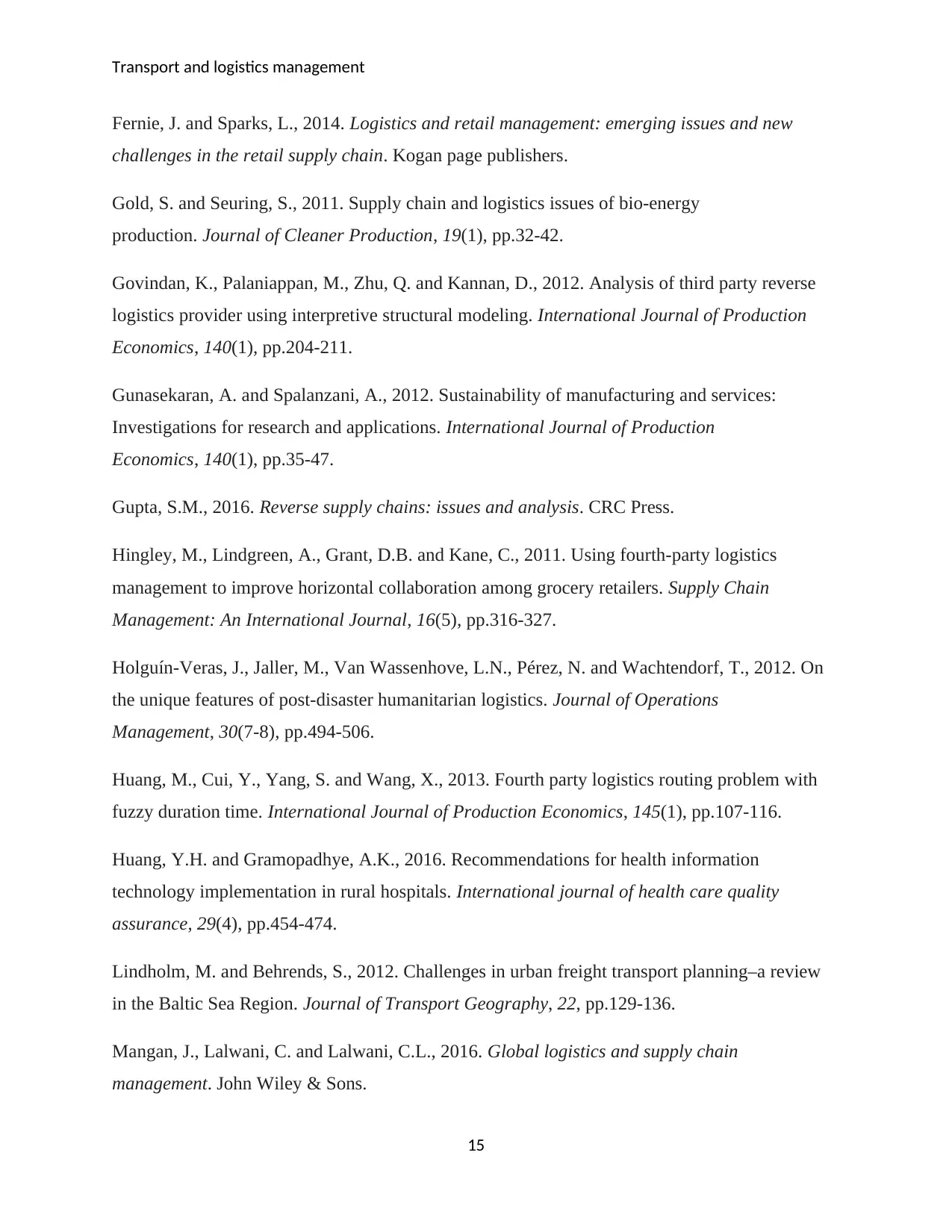
Transport and logistics management
Fernie, J. and Sparks, L., 2014. Logistics and retail management: emerging issues and new
challenges in the retail supply chain. Kogan page publishers.
Gold, S. and Seuring, S., 2011. Supply chain and logistics issues of bio-energy
production. Journal of Cleaner Production, 19(1), pp.32-42.
Govindan, K., Palaniappan, M., Zhu, Q. and Kannan, D., 2012. Analysis of third party reverse
logistics provider using interpretive structural modeling. International Journal of Production
Economics, 140(1), pp.204-211.
Gunasekaran, A. and Spalanzani, A., 2012. Sustainability of manufacturing and services:
Investigations for research and applications. International Journal of Production
Economics, 140(1), pp.35-47.
Gupta, S.M., 2016. Reverse supply chains: issues and analysis. CRC Press.
Hingley, M., Lindgreen, A., Grant, D.B. and Kane, C., 2011. Using fourth-party logistics
management to improve horizontal collaboration among grocery retailers. Supply Chain
Management: An International Journal, 16(5), pp.316-327.
Holguín-Veras, J., Jaller, M., Van Wassenhove, L.N., Pérez, N. and Wachtendorf, T., 2012. On
the unique features of post-disaster humanitarian logistics. Journal of Operations
Management, 30(7-8), pp.494-506.
Huang, M., Cui, Y., Yang, S. and Wang, X., 2013. Fourth party logistics routing problem with
fuzzy duration time. International Journal of Production Economics, 145(1), pp.107-116.
Huang, Y.H. and Gramopadhye, A.K., 2016. Recommendations for health information
technology implementation in rural hospitals. International journal of health care quality
assurance, 29(4), pp.454-474.
Lindholm, M. and Behrends, S., 2012. Challenges in urban freight transport planning–a review
in the Baltic Sea Region. Journal of Transport Geography, 22, pp.129-136.
Mangan, J., Lalwani, C. and Lalwani, C.L., 2016. Global logistics and supply chain
management. John Wiley & Sons.
15
Fernie, J. and Sparks, L., 2014. Logistics and retail management: emerging issues and new
challenges in the retail supply chain. Kogan page publishers.
Gold, S. and Seuring, S., 2011. Supply chain and logistics issues of bio-energy
production. Journal of Cleaner Production, 19(1), pp.32-42.
Govindan, K., Palaniappan, M., Zhu, Q. and Kannan, D., 2012. Analysis of third party reverse
logistics provider using interpretive structural modeling. International Journal of Production
Economics, 140(1), pp.204-211.
Gunasekaran, A. and Spalanzani, A., 2012. Sustainability of manufacturing and services:
Investigations for research and applications. International Journal of Production
Economics, 140(1), pp.35-47.
Gupta, S.M., 2016. Reverse supply chains: issues and analysis. CRC Press.
Hingley, M., Lindgreen, A., Grant, D.B. and Kane, C., 2011. Using fourth-party logistics
management to improve horizontal collaboration among grocery retailers. Supply Chain
Management: An International Journal, 16(5), pp.316-327.
Holguín-Veras, J., Jaller, M., Van Wassenhove, L.N., Pérez, N. and Wachtendorf, T., 2012. On
the unique features of post-disaster humanitarian logistics. Journal of Operations
Management, 30(7-8), pp.494-506.
Huang, M., Cui, Y., Yang, S. and Wang, X., 2013. Fourth party logistics routing problem with
fuzzy duration time. International Journal of Production Economics, 145(1), pp.107-116.
Huang, Y.H. and Gramopadhye, A.K., 2016. Recommendations for health information
technology implementation in rural hospitals. International journal of health care quality
assurance, 29(4), pp.454-474.
Lindholm, M. and Behrends, S., 2012. Challenges in urban freight transport planning–a review
in the Baltic Sea Region. Journal of Transport Geography, 22, pp.129-136.
Mangan, J., Lalwani, C. and Lalwani, C.L., 2016. Global logistics and supply chain
management. John Wiley & Sons.
15
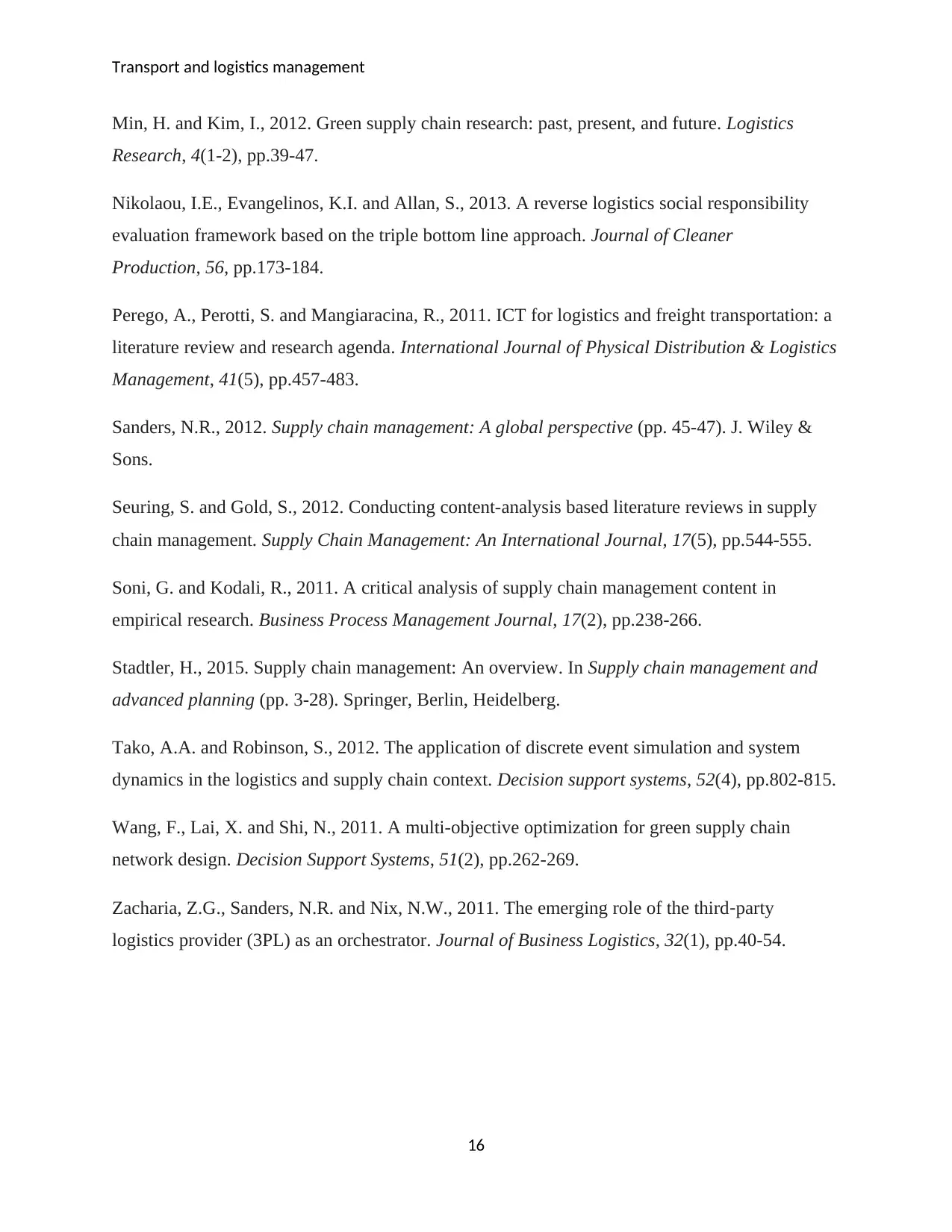
Transport and logistics management
Min, H. and Kim, I., 2012. Green supply chain research: past, present, and future. Logistics
Research, 4(1-2), pp.39-47.
Nikolaou, I.E., Evangelinos, K.I. and Allan, S., 2013. A reverse logistics social responsibility
evaluation framework based on the triple bottom line approach. Journal of Cleaner
Production, 56, pp.173-184.
Perego, A., Perotti, S. and Mangiaracina, R., 2011. ICT for logistics and freight transportation: a
literature review and research agenda. International Journal of Physical Distribution & Logistics
Management, 41(5), pp.457-483.
Sanders, N.R., 2012. Supply chain management: A global perspective (pp. 45-47). J. Wiley &
Sons.
Seuring, S. and Gold, S., 2012. Conducting content-analysis based literature reviews in supply
chain management. Supply Chain Management: An International Journal, 17(5), pp.544-555.
Soni, G. and Kodali, R., 2011. A critical analysis of supply chain management content in
empirical research. Business Process Management Journal, 17(2), pp.238-266.
Stadtler, H., 2015. Supply chain management: An overview. In Supply chain management and
advanced planning (pp. 3-28). Springer, Berlin, Heidelberg.
Tako, A.A. and Robinson, S., 2012. The application of discrete event simulation and system
dynamics in the logistics and supply chain context. Decision support systems, 52(4), pp.802-815.
Wang, F., Lai, X. and Shi, N., 2011. A multi-objective optimization for green supply chain
network design. Decision Support Systems, 51(2), pp.262-269.
Zacharia, Z.G., Sanders, N.R. and Nix, N.W., 2011. The emerging role of the third‐party
logistics provider (3PL) as an orchestrator. Journal of Business Logistics, 32(1), pp.40-54.
16
Min, H. and Kim, I., 2012. Green supply chain research: past, present, and future. Logistics
Research, 4(1-2), pp.39-47.
Nikolaou, I.E., Evangelinos, K.I. and Allan, S., 2013. A reverse logistics social responsibility
evaluation framework based on the triple bottom line approach. Journal of Cleaner
Production, 56, pp.173-184.
Perego, A., Perotti, S. and Mangiaracina, R., 2011. ICT for logistics and freight transportation: a
literature review and research agenda. International Journal of Physical Distribution & Logistics
Management, 41(5), pp.457-483.
Sanders, N.R., 2012. Supply chain management: A global perspective (pp. 45-47). J. Wiley &
Sons.
Seuring, S. and Gold, S., 2012. Conducting content-analysis based literature reviews in supply
chain management. Supply Chain Management: An International Journal, 17(5), pp.544-555.
Soni, G. and Kodali, R., 2011. A critical analysis of supply chain management content in
empirical research. Business Process Management Journal, 17(2), pp.238-266.
Stadtler, H., 2015. Supply chain management: An overview. In Supply chain management and
advanced planning (pp. 3-28). Springer, Berlin, Heidelberg.
Tako, A.A. and Robinson, S., 2012. The application of discrete event simulation and system
dynamics in the logistics and supply chain context. Decision support systems, 52(4), pp.802-815.
Wang, F., Lai, X. and Shi, N., 2011. A multi-objective optimization for green supply chain
network design. Decision Support Systems, 51(2), pp.262-269.
Zacharia, Z.G., Sanders, N.R. and Nix, N.W., 2011. The emerging role of the third‐party
logistics provider (3PL) as an orchestrator. Journal of Business Logistics, 32(1), pp.40-54.
16
1 out of 16
Related Documents
Your All-in-One AI-Powered Toolkit for Academic Success.
+13062052269
info@desklib.com
Available 24*7 on WhatsApp / Email
![[object Object]](/_next/static/media/star-bottom.7253800d.svg)
Unlock your academic potential
© 2024 | Zucol Services PVT LTD | All rights reserved.





